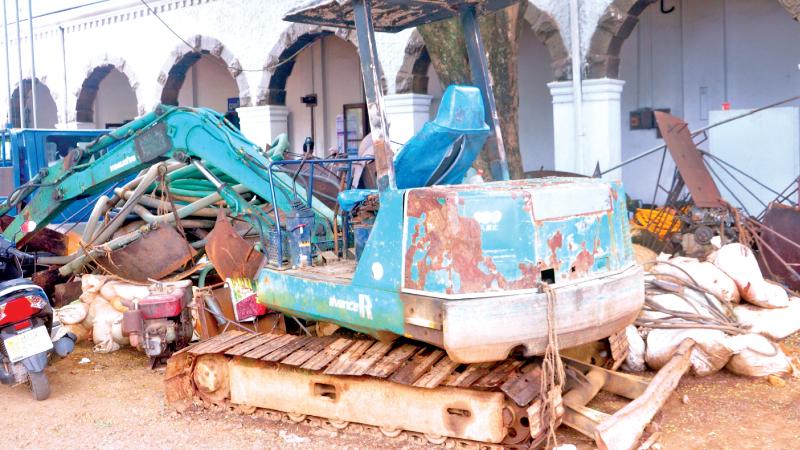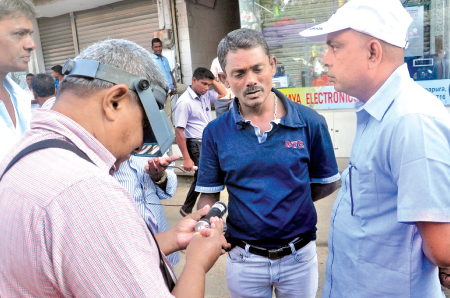
Gem mining has been an industry which had had the patronage of ancient kings of Sri Lanka. Records of gem mining and trading in the country go back to about 600 B.C. Ratnapura, known as the centre of the industry in the country has been depending on gem mining for centuries. Whether authorized or illegal, it has been the livelihood of many in the Ratnapura district. Now, with rules and regulations being strictly implemented by the National Gem and Jewellery Authority (NGJA) within the district, miners as well as dealers find life uncomfortable.
 Dressed in white with torches and visors in hand, a multitude awaits at the centre of the town. Many donned in ordinary clothes approach them. Here and there, they gather in groups, heads together, speaking in hushed tones. The deals close with goods and money changing hands. It is a market. Goods valuing hundreds of thousands of rupees exchange hands here, daily.
Dressed in white with torches and visors in hand, a multitude awaits at the centre of the town. Many donned in ordinary clothes approach them. Here and there, they gather in groups, heads together, speaking in hushed tones. The deals close with goods and money changing hands. It is a market. Goods valuing hundreds of thousands of rupees exchange hands here, daily.
Upul Weerasinghe is not dressed in white. However, he has the signature equipment of the gem dealers in hand. A torch which he claims, has a powerful “5 cell, heat resistant bulb which doesn’t blow off easily, and costs over a thousand rupees each.” He wears a visor as well. “This is called an opti-viser,” he explains. One of the essential items in the business of purchasing gems, the visor, gives them a sharper, 4 times enlarged vision of the item, that would make identification of faults easier, than with the naked eye.
Close upon 25 years, he had been in the business of purchasing ‘geuda’ or the milky corundum, a less developed and therefore, less valuable form of the mineral which turns into sapphire. Heat treatment would turn the unattractive cloudy grey-white stone to a bright, sparkling blue. A ‘friend’ is involved in the business of burning geuda and selling them to Thai merchants in Bangkok, says Weerasinghe. He is the middle man, supplying raw material. For over 20 years, the business had helped support his family. Though the trading “could be better, with more gems flowing in the market,” that had had no adverse effect on his business.
W. Wimaladasa wants to sell the collection of gems that nestles in his palm. In various shades of brown and green, the least blackish one could fetch about a hundred thousand rupees, he guesses. “It is the light coloured ones which are more expensive,” elaborates Wimaladasa.
For over 20 years, he had been a middle man purchasing gems from miners throughout the district and selling them in the ‘markets’ at the town centre. “In the morning, I work here and in the evening visit the villages searching for gems,” he explains. How does he find the business at present? “Because there are less gems coming into the market we have to go in search, in interior villages, and the buyers now don’t give money upfront. We have to wait for months to get the money,” he laments.
Chaminda Jayakumara is vociferous. Involved in the trade for the past 25 years, he is certainly against the curbing of illegal mining. He raises accusations against the raids conducted by the NGJA.
“They do not let us mine, either in the river or around it. We had some concessions some time ago. For a month or two before New Year, they let us mine to find some money to celebrate Avurudu. This time there is nothing. If we get into the river with our baskets and mamoties they come with the Special Task Force (STF) to arrest us. But those who use backhoes in the river go scot free. They do not catch the big traders or those with political clout,” he alleges.
 Sugath Weerawardhana, Wasantha Kumara, Rasika Nayanakantha and P.A. Piyatissa are all traders involved in purchasing, as well as selling. Their experiences in the gem trade range between 15 to 30 years. “We have been involved in mining ourselves,” they declare proudly. “After we gained experience in identifying gems, nitty-gritties, tips and tricks we started trading here,” they explain. It is the small-scale traders and miners who have been affected by the recent changes in the economy, as well as the regulations, they comment. “About 80 percent of the population in Ratnapura depend on the gem trade, directly or indirectly.
Sugath Weerawardhana, Wasantha Kumara, Rasika Nayanakantha and P.A. Piyatissa are all traders involved in purchasing, as well as selling. Their experiences in the gem trade range between 15 to 30 years. “We have been involved in mining ourselves,” they declare proudly. “After we gained experience in identifying gems, nitty-gritties, tips and tricks we started trading here,” they explain. It is the small-scale traders and miners who have been affected by the recent changes in the economy, as well as the regulations, they comment. “About 80 percent of the population in Ratnapura depend on the gem trade, directly or indirectly.
There are about 50% who depend directly. The price of equipment has gone up, so that the cost is high. And the regulators are implementing the rules strictly due to environmental impact. Licence costs more and they have cut off concessions. So, it is people like us, the small scale traders who have to face difficulties,” they affirm. Small-scale traders without affluence and influence face a hard time, they say.
“If environmental impact is of concern, they should stop all activities related to the degrading of the river. What we see is, while some traders are being allowed to mine with backhoes and other machinery, small-time miners are taken into custody. Though gem mining is banned, sand mining is not. Many large-scale traders as well as those who have political affiliation take advantage of this. Also, there is no development in the gem trade. We have been using the same equipment and methods for the past so many years” they claim.
It is not only the small-scale traders who are caught when the NGJA carries out raids, says D. T. Kulananda, Director, National Enforcement and Regional Development, NGJA. The backhoes and other machinery at the Ratnapura Regional Office premises are proof. The authority carries out 50 to 100 raids a month in the district, based on recommendations from area Enforcement Officers. While the NGJA holds authority over gem mining, they don’t have authority over sand mining, he explains.
It is the Geological Survey and Mines Bureau (GSMB) that regulates sand mining. However, illegal miners take advantage of the situation, reveals Kulananda, “When we conduct a raid, they tell us they are sand miners. When the GSMB conducts a raid they pretend to be gem miners. So, we have taken other measures to stop them circumvent the situation.” The NGJA officers are supported by both, the STF and the Police on raids, he explains. “We requested the support of the STF when the authority officers in raiding parties were beaten by the miners. It is for our safety. If the gem-pits are licensed, there is no problem. The licence is what we request for, first.
However, if they fail to produce the licence, we have to treat the case as illegal mining. It is mandatory for them to keep the licence in hand. ”The NGJA’s Ratnapura Regional Office, issues around 3,000 licences for gem mining, 2,000 for sales and 700 to 800 for auctions each year. Further, the authority offers a range of services including, certification of gems which could be obtained by anyone at a nominal charge.
What does he have to say about the general claim that the gem trade is declining? “It is true there are a less number of stones circulating in the market. It is due to raiding and stoppage of illegal gemming. However, this is not what affects the current decline. The depreciation of the dollar and the recession in the European Continent affects the industry at present,” he stresses. The USA and EU countries stand as major export markets for Sri Lankan gems and jewellery.
